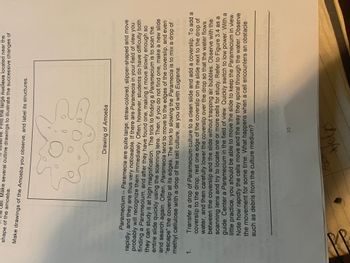
Human Physiology: From Cells to Systems (MindTap Course List)
9th Edition
ISBN: 9781285866932
Author: Lauralee Sherwood
Publisher: Cengage Learning
expand_more
expand_more
format_list_bulleted
Concept explainers
Question

Transcribed Image Text:**Title: Observing Paramecia and Amoeba**
**Drawing of Amoeba**
- The image features a hand-drawn illustration of an amoeba, showcasing its irregular shape with protruding pseudopods.
**Text Details:**
*Paramecium* — Paramecia are quite large, straw-colored, slipper-shaped, and move rapidly, making them very noticeable. If there are Paramecia in your field of view, you will likely recognize them immediately. Students often have trouble both finding a Paramecium and then slowing it down enough to study under high magnification. The key to finding a Paramecium is to scan the entire slide quickly using the scanning lens. If none are visible, create a new slide and search again.
Paramecia tend to move to the edges of the coverslip and can even "escape" the coverslip at its edges. To slow down the Paramecia, mix a drop of methyl cellulose with a drop of the cell culture, as done with *Euglena*.
**Procedure:**
1. Transfer a drop of Paramecium culture to a clean slide and add a coverslip carefully to avoid trapping air bubbles.
2. Use the scanning lens to locate one or more cells.
3. Center a Paramecium in the field of view and quickly switch to low power. With practice, you can maintain the Paramecium in view.
4. Observe the rapid movement and characteristic spiraling in water. Note the behavior over time, particularly when encountering obstacles like debris from the culture medium.
What happens when a cell encounters an obstacle? (Space for observation notes)
---
This content is suitable for an educational website, providing detailed instructions and observations for studying microscopic organisms.
Expert Solution
This question has been solved!
Explore an expertly crafted, step-by-step solution for a thorough understanding of key concepts.
This is a popular solution
Trending nowThis is a popular solution!
Step by stepSolved in 3 steps with 1 images

Knowledge Booster
Learn more about
Need a deep-dive on the concept behind this application? Look no further. Learn more about this topic, biology and related others by exploring similar questions and additional content below.Similar questions
- Protists that have a pellicle are surrounded by ___________ . silica dioxide calcium carbonate carbohydrates proteinsarrow_forwardWhich parasitic protist evades the host immune system by altering its surface proteins with each generation? a. Paramecium caudatum b. Trypanosoma brucci c. Plasmodium falciparum d. Phytophthora infrstansarrow_forwardMembers of which phylum produce a club shaped structure that contains spores? Chytridiomycota Basidicmycota Glomeromycota Ascomycotaarrow_forward
- Bacteria that cause the disease typhus arc close relatives of bacteria that evolved into __________. a. protists b. protocells c. chioroplasts d. mitochondriaarrow_forwardPiotists with the capabilities to perform photosynthesis and to absorb nutrients from dead organisms are called _____________. photoautotrophs mixotrophs saprobes heterotrophsarrow_forwardA marine biologist analyzing water samples notices a protist with a calcium carbonate shell that moves by pseudopodia extension. The protist is likely to be closely related to which species? Fuligo septica (Dog Vomit slime mold) Circogonia icosahedra (Radiolarian) Eugiena viridis Ammonia tepidaarrow_forward
- Sudoriferous glands produce______. a. sweat b. lipids c. sebum d. milkarrow_forwardThe sister taxon of the Chordata is the. Mollusca Arthropoda Ambulacraria Rotiferaarrow_forwardMitochondria most likely evolved by ___________ . a photosynthetic cyanobacterium cytoskeletal elements endosymbiosis membrane proliferationarrow_forward
arrow_back_ios
arrow_forward_ios
Recommended textbooks for you
 Human Physiology: From Cells to Systems (MindTap ...BiologyISBN:9781285866932Author:Lauralee SherwoodPublisher:Cengage Learning
Human Physiology: From Cells to Systems (MindTap ...BiologyISBN:9781285866932Author:Lauralee SherwoodPublisher:Cengage Learning Medical Terminology for Health Professions, Spira...Health & NutritionISBN:9781305634350Author:Ann Ehrlich, Carol L. Schroeder, Laura Ehrlich, Katrina A. SchroederPublisher:Cengage Learning
Medical Terminology for Health Professions, Spira...Health & NutritionISBN:9781305634350Author:Ann Ehrlich, Carol L. Schroeder, Laura Ehrlich, Katrina A. SchroederPublisher:Cengage Learning Biology Today and Tomorrow without Physiology (Mi...BiologyISBN:9781305117396Author:Cecie Starr, Christine Evers, Lisa StarrPublisher:Cengage Learning
Biology Today and Tomorrow without Physiology (Mi...BiologyISBN:9781305117396Author:Cecie Starr, Christine Evers, Lisa StarrPublisher:Cengage Learning

Human Physiology: From Cells to Systems (MindTap ...
Biology
ISBN:9781285866932
Author:Lauralee Sherwood
Publisher:Cengage Learning

Medical Terminology for Health Professions, Spira...
Health & Nutrition
ISBN:9781305634350
Author:Ann Ehrlich, Carol L. Schroeder, Laura Ehrlich, Katrina A. Schroeder
Publisher:Cengage Learning

Biology Today and Tomorrow without Physiology (Mi...
Biology
ISBN:9781305117396
Author:Cecie Starr, Christine Evers, Lisa Starr
Publisher:Cengage Learning


